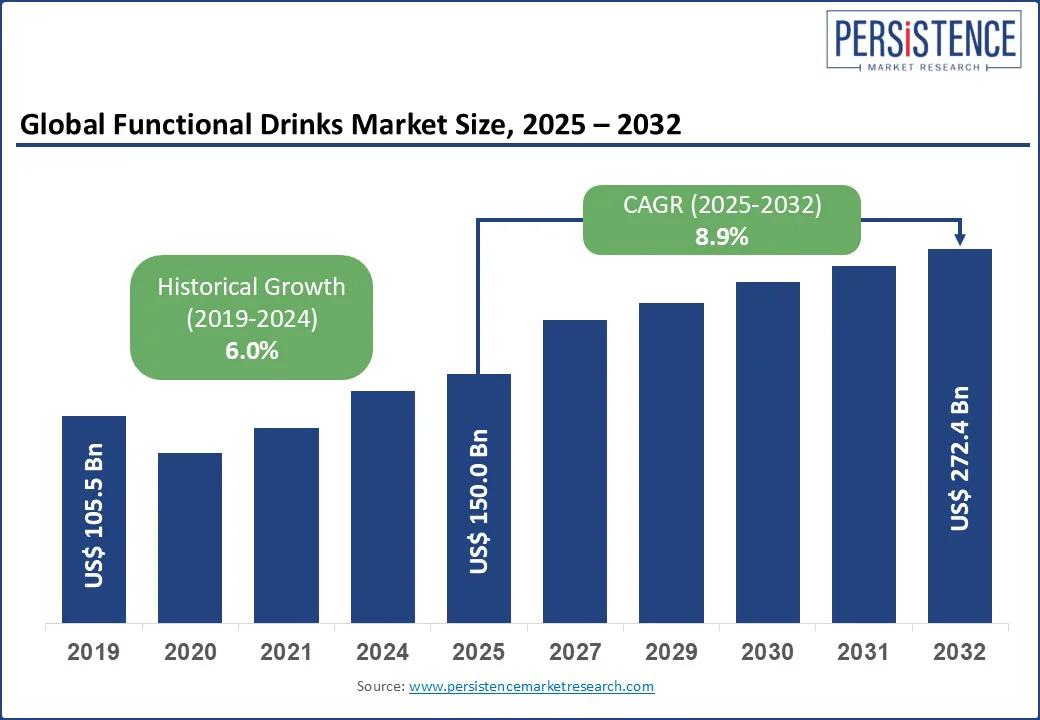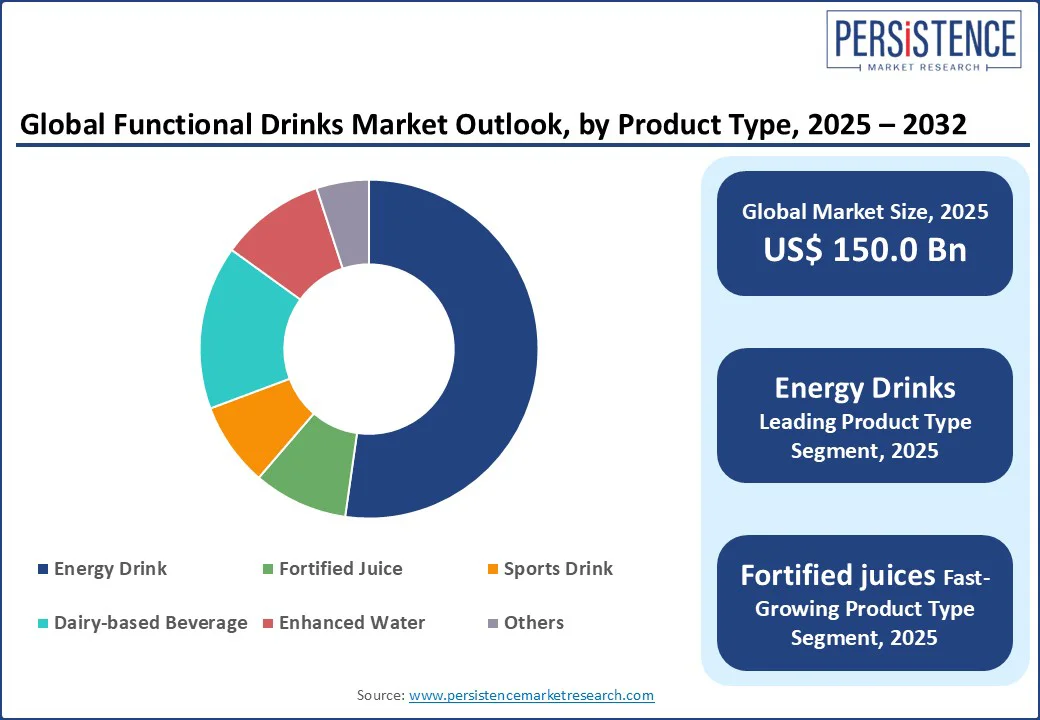ID: PMRREP3071| 210 Pages | 12 Aug 2025 | Format: PDF, Excel, PPT* | Food and Beverages

The global functional drinks market size is likely to value at US$150 Bn in 2025 and reach US$272.4 Bn by 2032, registering a CAGR of 8.9% during the forecast period 2025-2032.
Market growth is fueled by increasing consumer awareness of health and wellness, rising demand for nutrient-enriched beverages, and innovative product formulations by leading brands.

Key Industry Highlights:
|
Global Market Attribute |
Key Insights |
|
Functional Drinks Market Size (2025E) |
US$150 Bn |
|
Market Value Forecast (2032F) |
US$272.4 Bn |
|
Projected Growth (CAGR 2025 to 2032) |
8.9% |
|
Historical Market Growth (CAGR 2019 to 2024) |
6.0% |
The functional drinks market is propelled by increasing health consciousness and the growing prevalence of lifestyle diseases. The global rise in obesity and type 2 diabetes has driven demand for low-calorie, nutrient-enriched beverages. For instance, according to the World Health Organization, over 650 Mn adults were obese in 2022, with obesity rates nearly tripling since 1975. Functional drinks, such as fortified juices and enhanced water, offer low-sugar, vitamin-enriched options that align with dietary guidelines.
Urbanization and fast-paced lifestyles continue to drive demand for convenient, on-the-go functional beverages. Energy and sports drinks that offer rapid hydration and energy boosts are gaining popularity, especially among working professionals and athletes. In markets such as the U.S., younger consumers are increasingly opting for functional beverages as healthier alternatives to traditional carbonated drinks. Government-backed nutrition programs further support market growth. In India, initiatives such as the National Nutrition Mission have actively promoted fortified beverages through school-based and public health channels. These programs underscore the importance of functional drinks in combating micronutrient deficiencies among vulnerable groups, including children and pregnant women, thereby encouraging institutional adoption.
The functional drinks market faces challenges due to consumer skepticism about health claims and high production costs. Many consumers question the benefits of functional beverages, particularly energy drinks, due to concerns about artificial ingredients and high caffeine content. A 2022 International Food Information Council survey found that 42% of U.S. consumers avoided energy drinks, citing risks to heart health and overstimulation. This skepticism restricts adoption among older demographics and those preferring natural alternatives.
High production costs for fortified and clean-label drinks also hinder growth. Incorporating premium ingredients such as plant-based proteins, vitamins, or natural sweeteners increases manufacturing expenses. For example, fortifying beverages with vitamin D or omega-3 can raise production costs, as per industry estimates. These costs are often passed to consumers, limiting accessibility in price-sensitive markets such as rural India or Sub-Saharan Africa.
The functional drinks market offers significant opportunities through product innovation and sustainable packaging. The rise of plant-based and clean-label beverages caters to growing consumer demand for transparency and eco-friendly products. In 2023, plant-based functional drinks, such as those fortified with pea protein or almond milk, saw a sales increase in Europe, driven by vegan and flexitarian diets. Companies can capitalize by developing formulations combining functional benefits with natural ingredients.
Sustainable packaging is another growth avenue. With global concerns about plastic waste, brands are adopting biodegradable and recyclable options. In 2024, Coca-Cola introduced 100% recycled PET bottles for its Smartwater brand in Europe, enhancing brand loyalty among eco-conscious consumers. In the Asia Pacific, companies such as Vinamilk are exploring carton-based packaging for fortified juices, extending shelf life, and reducing environmental impact.
The rise of e-commerce is creating significant opportunities for the functional beverage market. Online platforms, including subscription-based services and direct-to-consumer channels, are becoming increasingly popular for purchasing health-oriented drinks. Brands are capitalizing on this trend by using digital marketing strategies and personalized product recommendations to engage niche consumer groups, such as fitness enthusiasts and health-conscious families. This digital shift allows for broader market reach and enhanced consumer loyalty.
The functional drinks market is segmented into fortified juice, energy drinks, sports drinks, dairy-based beverages, enhanced water, and others. Energy drinks dominate the segment, expected to account for approximately 52.1% of the market share in 2025, due to their appeal to young adults, athletes, and professionals seeking performance enhancement. Brands such as Red Bull and Monster have solidified their position through aggressive marketing and sponsorships in sports and gaming. Their versatility in social settings, such as parties or gyms, further drives adoption.
Fortified juices are the fastest-growing segment, fueled by rising demand for vitamin-enriched, low-sugar beverages. These drinks appeal to health-conscious consumers, particularly in urban areas, where they are consumed as meal replacements or snacks. Products such as Tropicana Essentials and Minute Maid NutriForce, fortified with vitamins A, C, and D, have gained traction for their role in addressing nutrient deficiencies without added sugars.
Supermarkets/hypermarkets lead the distribution channels, expected to account for 40% of the market share in 2025. Their dominance stems from wide product availability, competitive pricing, and consumer trust in established retail chains. Retailers such as Walmart and Tesco offer extensive ranges of functional drinks, catering to diverse consumer preferences.
Online stores are the fastest-growing channel, driven by the convenience of e-commerce and the rise of subscription-based models. Platforms such as Amazon and health-focused retailers such as Thrive Market have expanded their functional drink offerings, providing personalized recommendations and bulk purchase options. The shift toward online shopping, accelerated by the COVID-19 pandemic, continues to boost this channel’s growth.

In North America, the U.S. dominates with a market share of approximately 37.5% in 2025, driven by high consumer spending on health and wellness products. The U.S. functional drink market is experiencing strong growth, driven by evolving consumer preferences and rising health consciousness. Energy drinks and enhanced water continue to lead the category, supported by the increasing popularity of fitness culture and the demand for low-calorie, high-protein beverages. Leading brands such as Gatorade and BodyArmor are expanding their offerings in the sports drink segment, while newer entrants such as Liquid IV are gaining traction with hydration-focused beverages enriched with electrolytes and vitamins.
Clean-label and organic options are becoming increasingly important to consumers. Brands such as Suja Juice and Health-Ade Kombucha are witnessing high popularity due to their natural ingredients and transparent formulations. Sustainability is also a major focus in the U.S. market, with companies introducing recyclable packaging and committing to environmentally responsible practices. In the premium segment, ethical sourcing and transparency, such as the use of fair-trade ingredients are emerging as key brand differentiators.
Europe’s functional drinks market is led by Germany, the U.K., and France, driven by stringent regulations and increasing consumer demand for clean-label products. Germany maintains the largest market share, with a strong focus on energy drinks and fortified juices. The popularity of international brands such as Red Bull, along with local names such as Effect Energy, underscores this trend. Environmental policies under the EU’s Green Deal, along with restrictions on single-use plastics, are encouraging companies to adopt sustainable packaging solutions, with formats such as Tetra Pak cartons gaining traction for fortified beverages.
In the U.K., the market is fueled by health-conscious millennials and Gen Z consumers who favor low-sugar, plant-based drinks. Brands such as Innocent Drinks and Naked Juice are expanding their fortified juice offerings, emphasizing transparency and natural ingredient profiles. Meanwhile, France is witnessing steady growth in dairy-based functional beverages, with products such as Danone’s Activia Drink leading in consumer preference. Regulatory encouragement for nutrient fortification and environmentally friendly packaging continues to support overall market growth across the region.
Asia Pacific is expected to achieve a CAGR of 10.2% by 2032, led by India, China, and Japan. In India, fortified juices and dairy-based beverages dominate the functional drinks market, driven by affordability and strong support from government-backed nutrition programs. Leading players such as Amul and Mother Dairy have broadened their portfolios with fortified juice and milk-based drink options, effectively targeting both urban and rural demographics. The market is bolstered by increasing health awareness and the ongoing trend of urbanization.
China’s functional drink sector is largely propelled by demand for energy drinks and enhanced water. Prominent brands such as Nongfu Spring and Red Bull continue to lead the segment. The expansion of the middle class and growing interest in fitness have significantly contributed to increased consumption, particularly in the sports drink category.

The global functional drinks market is highly competitive, with a mix of global giants and regional players vying for market share. Companies compete on product innovation, pricing, and distribution efficiency. The rise of plant-based and organic drinks has intensified competition, as consumers demand transparency and sustainability. Digital marketing and partnerships with fitness influencers are key strategies for brand differentiation.
The functional drinks market is projected to reach US$150 Bn in 2025.
Rising health consciousness, urbanization, and government nutrition programs are the key market drivers.
The functional drinks market is poised to witness a CAGR of 8.9% from 2025 to 2032.
Innovation in plant-based drinks and sustainable packaging is the key market opportunities.
Bartek Ingredients Inc., Danone S.A., and Prinova Group LLC are among the key market players.
|
Report Attribute |
Details |
|
Historical Data/Actuals |
2019 - 2024 |
|
Forecast Period |
2025 - 2032 |
|
Market Analysis Units |
Value: US$ Bn, Volume: As Applicable |
|
Geographical Coverage |
|
|
Segmental Coverage |
|
|
Competitive Analysis |
|
|
Report Highlights |
|
|
Customization and Pricing |
|
By Product Type
By Distribution Channel Type
By Region
Delivery Timelines
For more information on this report and its delivery timelines please get in touch with our sales team.
About Author